It's All About Couplings
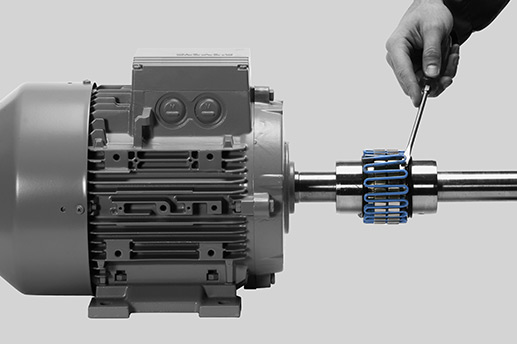
Used to connect driving equipment to driven equipment, couplings are a critical machine component that can sometimes be overlooked when it comes to selection and maintenance. These critical components come in many different shapes and sizes, so it can be confusing trying to navigate what couplings are used for, what they do, and which couplings are best for your machinery.
We have put together the essential list of everything you need to know about each different type of Coupling, including their features and benefits and in what machinery you will often find them:
Flexible Couplings
Flexible Couplings come in many different variations, but all of these have 1 thing in common – its elastomeric properties. These properties typically come in the form of an elastomer or elastic type element that is often made of a rubber or urethane compound. This element absorbs impact, dampens vibrations, and cushions shock loads, making it ideal for applications with high shaft misalignment. Depending on your application, the type of flexible coupling you use differs and can provide additional benefits to your machine.
Jaw Couplings
 Jaw couplings are made up of 3 parts, two metallic hubs and an elastomeric spacing element (also known as a spider) this means depending on your application, these couplings offer different levels of dampening protection. In addition, these versatile couplings have a fail-safe design, meaning that even if the spider fails, the coupling can continue to operate without its dampening properties until the spider is replaced. They also do not require lubrication during operation, making them a low maintenance option that helps to reduce machine downtime for your business.
Jaw couplings are made up of 3 parts, two metallic hubs and an elastomeric spacing element (also known as a spider) this means depending on your application, these couplings offer different levels of dampening protection. In addition, these versatile couplings have a fail-safe design, meaning that even if the spider fails, the coupling can continue to operate without its dampening properties until the spider is replaced. They also do not require lubrication during operation, making them a low maintenance option that helps to reduce machine downtime for your business.
Tyre Couplings
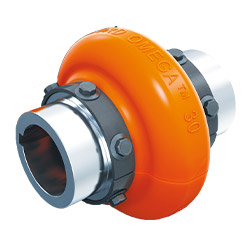 Tyre couplings have two metal hubs with a tyre shaped spacer positioned in between – this enables the coupling to transmit torque. The tyre also gives this coupling outstanding vibration dampening capabilities and excellent resistance to shock loads, helping to extend the life of the connected equipment in a wide range of industries.
Tyre couplings have two metal hubs with a tyre shaped spacer positioned in between – this enables the coupling to transmit torque. The tyre also gives this coupling outstanding vibration dampening capabilities and excellent resistance to shock loads, helping to extend the life of the connected equipment in a wide range of industries.
Gear Couplings
 Gear couplings are a great option for universal use and are often suitable for most applications as they can transmit high torque while working at low speeds.
Gear couplings are a great option for universal use and are often suitable for most applications as they can transmit high torque while working at low speeds.
Curved tooth gear couplings
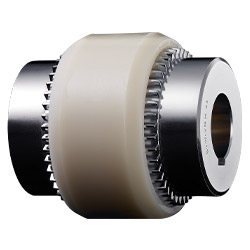 Curved tooth gear couplings are known for their easy of assembly and their maintenance free operation making them ideal for inhospitable environments. These couplings also have a good resistance to chemicals, meaning they offer a low cost, reliable service for industries such as: Minerals & Mills, Pulp & Paper, Petrochemical, Oil & Gas, Machine Tools and Railway.
Curved tooth gear couplings are known for their easy of assembly and their maintenance free operation making them ideal for inhospitable environments. These couplings also have a good resistance to chemicals, meaning they offer a low cost, reliable service for industries such as: Minerals & Mills, Pulp & Paper, Petrochemical, Oil & Gas, Machine Tools and Railway.
Claw Couplings
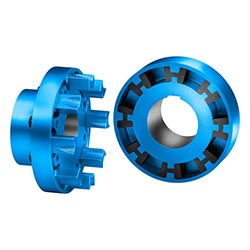 Claw couplings can be a great option for machinery where either angular, parallel or axial shaft misalignment is an issue. These couplings generally have a short overall length, meaning they are suitable for applications where space on the shaft is limited. Similar to other flexible couplings, a claw couplings elastic element dampens vibration and cushions shock loads, helping to extend the life of surrounding equipment in a range of industries.
Claw couplings can be a great option for machinery where either angular, parallel or axial shaft misalignment is an issue. These couplings generally have a short overall length, meaning they are suitable for applications where space on the shaft is limited. Similar to other flexible couplings, a claw couplings elastic element dampens vibration and cushions shock loads, helping to extend the life of surrounding equipment in a range of industries.
Pin & Bush Couplings
 Another fail-safe coupling option is pin and bush couplings. These couplings also have fantastic vibration and shock load dampening properties, all while accommodating up to 0.5° of misalignment. Also, their fail-safe design make them ideal for use in safety equipment such as fire pumps and elevator drives.
Another fail-safe coupling option is pin and bush couplings. These couplings also have fantastic vibration and shock load dampening properties, all while accommodating up to 0.5° of misalignment. Also, their fail-safe design make them ideal for use in safety equipment such as fire pumps and elevator drives.
Grid Coupling
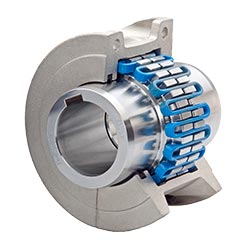 When your application has high levels of vibration and large shock loads, grid couplings are the ideal solution. Due to the grid that runs between the two slotted hubs of the coupling, these components have a high torsional flexibility. This helps to reduce vibration, which aids in prolonging the life of the surrounding drive equipment.
When your application has high levels of vibration and large shock loads, grid couplings are the ideal solution. Due to the grid that runs between the two slotted hubs of the coupling, these components have a high torsional flexibility. This helps to reduce vibration, which aids in prolonging the life of the surrounding drive equipment.
Back-lash Free Couplings
Back-lash free couplings are often found in applications where precision is key. Back-lash occurs because of the spacing of components within an application, this backlash often accumulates in the couplings as the joining piece for components. Using a back-lash free coupling minimises the effects of backlash within the system, helping to increase accuracy levels. These couplings come in the form of:
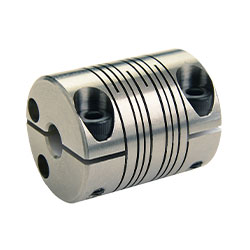 Beam Couplings - Machined from a single piece of aluminium or stainless steel, beam couplings offer torsional stiffness while compensating for misalignment and back-lash – ideal for high-speed applications that require high accuracy.
Beam Couplings - Machined from a single piece of aluminium or stainless steel, beam couplings offer torsional stiffness while compensating for misalignment and back-lash – ideal for high-speed applications that require high accuracy.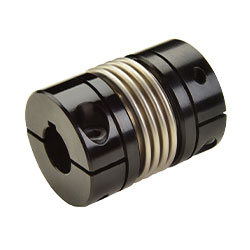 Bellows Couplings – These couplings are able to flex while remaining rigid under torsional loads, meaning it can accurately transmit velocity, angular position, and torque. It’s ability to flex also allows for parallel & angular misalignment and axial motion.
Bellows Couplings – These couplings are able to flex while remaining rigid under torsional loads, meaning it can accurately transmit velocity, angular position, and torque. It’s ability to flex also allows for parallel & angular misalignment and axial motion. Oldham Couplings – Oldham couplings are the ideal solution for high levels of parallel misalignment, while also being a highly customisable to suit your specific applications needs. These couplings are often found in a range of industries such as food & beverage, pharmaceutical & medical, and semiconductor applications.
Oldham Couplings – Oldham couplings are the ideal solution for high levels of parallel misalignment, while also being a highly customisable to suit your specific applications needs. These couplings are often found in a range of industries such as food & beverage, pharmaceutical & medical, and semiconductor applications.
Rigid Couplings
Rigid Couplings are often found in lower speed or lower torque applications and are used where a solid connection is required between two shafts of the same size. They tend to be high strength couplings that are used to maintain alignment between shafts. These couplings are often considered the most basic, but most cost-effective coupling.
One piece, two piece and set screw rigid couplings
There are three different variations of rigid couplings, each provide different features and benefits for applications. These variations include:
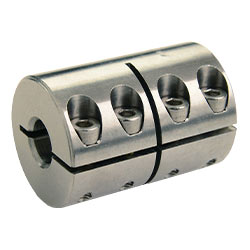 One-piece rigid couplings – good holding power but disassembly of surrounding equipment is needed for fitting.
One-piece rigid couplings – good holding power but disassembly of surrounding equipment is needed for fitting.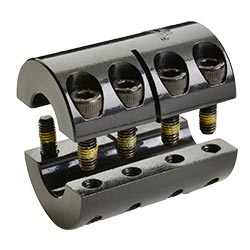 Two-piece rigid couplings – The highest holding power of all rigid coupling with a two-part split design making fitting and removal much easier.
Two-piece rigid couplings – The highest holding power of all rigid coupling with a two-part split design making fitting and removal much easier. Set screw rigid couplings – This variation is screwed to the shaft but again, requires disassembly of surrounding equipment for fitting and removal.
Set screw rigid couplings – This variation is screwed to the shaft but again, requires disassembly of surrounding equipment for fitting and removal.
Torsionally Rigid Couplings
 Torsionally rigid couplings are generally suitable for most industrial applications. This category includes disc and composite couplings. These can feature zero back-lash, low-restoring forces, and electrically insulated designs.
Torsionally rigid couplings are generally suitable for most industrial applications. This category includes disc and composite couplings. These can feature zero back-lash, low-restoring forces, and electrically insulated designs.
Other Couplings
These Couplings can fall into either flexible or rigid depending on the requirements of your application.
Flywheel Couplings
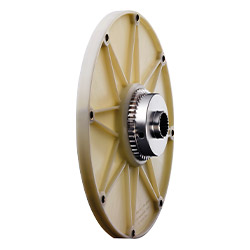 Flywheel couplings, also known as flange couplings, is a torsionally rigid coupling that provide maintenance free operation that’s free from resonance. This makes them ideal for applications such as cranes, harvesting machines and floor conveyors.
Flywheel couplings, also known as flange couplings, is a torsionally rigid coupling that provide maintenance free operation that’s free from resonance. This makes them ideal for applications such as cranes, harvesting machines and floor conveyors.
Chain Couplings
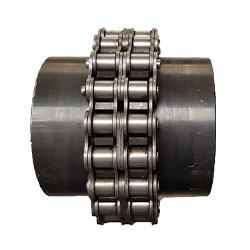 Chain couplings have flanges that are linked with duplex roller chains, meaning they are a high strength coupling option. Not only this, but these couplings can transmit high levels of torque AND accommodate up to 2° of misalignment, helping to protect surrounding equipment from damage.
Chain couplings have flanges that are linked with duplex roller chains, meaning they are a high strength coupling option. Not only this, but these couplings can transmit high levels of torque AND accommodate up to 2° of misalignment, helping to protect surrounding equipment from damage.
Fluid Couplings
 Where vibration in machinery is high, you may find a fluid coupling. This is because these couplings have an excellent level of vibration dampening and provide a controlled soft start up. Commonly found in applications such as conveyors, mills, shredders, crushers and agitators, fluid couplings can withstand the harsh conditions found in the environments these applications are often found.
Where vibration in machinery is high, you may find a fluid coupling. This is because these couplings have an excellent level of vibration dampening and provide a controlled soft start up. Commonly found in applications such as conveyors, mills, shredders, crushers and agitators, fluid couplings can withstand the harsh conditions found in the environments these applications are often found.
This is just a basic overview of the different types of couplings that Acorn can provide, alongside custom solutions, we can help you to find the exact coupling your machine needs. Our specialised Couplings & Drives department are on hand to answer all of your coupling questions and queries, so get in touch with them today.
